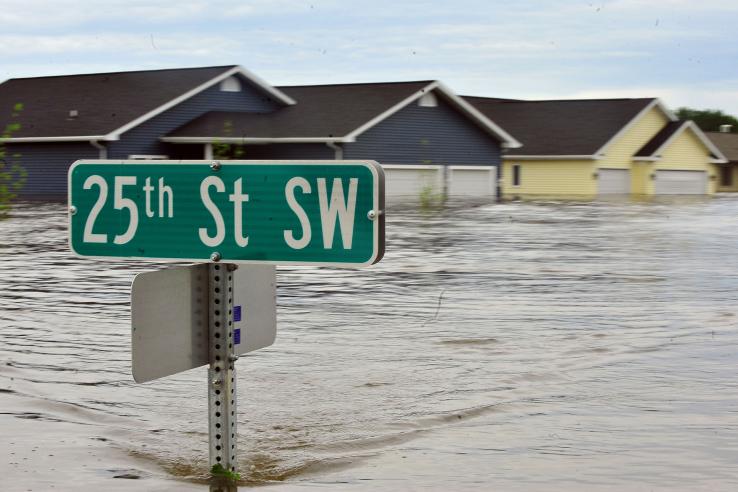
An agenda for climate change research in North America

As part of a blog series on J-PAL’s work related to climate change, this post highlights J-PAL North America’s contributions to the evidence base in environment, energy, and climate change to date and articulates our agenda for catalyzing more policy-relevant research in collaboration with the King Climate Action Initiative (K-CAI) at J-PAL. In an earlier post, our Energy, Environment, and Climate Change sector team reflects on the nexus of climate change and poverty and on the need for evidence-informed climate policy.
In collaboration with our J-PAL colleagues around the globe, the J-PAL North America regional office is taking time to reflect on how the consequences of a changing climate are already affecting communities both worldwide and in our own region.
In North America and globally, structural disparities and discrimination have led to low-income populations and people of color disproportionately experiencing a range of climate change-related hazards including (though not limited to) air and water pollution, loss of livelihoods, and elevated risk of harm from extreme weather events and extreme heat.
As a global organization, J-PAL is working to understand how we can support human development while also better protecting our environment and climate. In the North America region, our network of affiliated professors is working to understand how to most effectively reduce greenhouse gas emissions, reduce carbon co-pollutants that have immediate health consequences, and lower the burden that climate change poses for vulnerable populations in the region.
Climate change priorities in North America
As outlined in the earlier post, climate change and poverty are closely related. Within North America, low-income communities already grapple with the consequences of a changing climate. Researchers also project that issues such as rising temperatures, increases in the frequency of extreme weather, and sea level rise will continue to disproportionately affect people experiencing poverty in the region.
With the United States as the second largest emitter of greenhouse gases in the world, reducing emissions within North America is essential to addressing the dual challenges of poverty and climate change around the world.
This is also important because carbon co-pollutants cause disproportionately high rates of health problems for people experiencing poverty. The current global pandemic is further revealing the linkages between exposure to environmental pollution and increased COVID-19 infection rates, which disproportionately affect low-income neighborhoods and communities of color that tend to be exposed to higher levels of air pollution. Increases in particulate matter and other air pollutants lead to increases in respiratory health problems for children in the United States, particularly for children from low-income households. For these reasons, reducing pollution is a priority area of climate change research for J-PAL North America.
Particularly for communities that are projected to feel the effects of climate change and local pollutants most intensely, rapid adaptation is essential.
However, more research is needed in the context of North America to measure the impacts of common approaches to help communities cope with the impacts of a changing climate.
These can include, for example, updating physical infrastructure such as urban centers and transportation infrastructure to be more resilient to extreme weather, creating cooling centers and community response networks to respond to periods of extreme heat, supporting agricultural institutions and workers in adapting to changing conditions, and training communities for emergency preparedness for extreme weather events.
Leveraging existing evidence: lessons from household energy efficiency programs
J-PAL North America supports the generation of rigorous evidence on equitable programs that address the causes and consequences of challenges in environment, energy, and climate change, and synthesizes evidence on these issues into accessible policy lessons.
One area where rigorous evidence generated by J-PAL affiliated researchers—and by researchers and practitioners from a wide range of fields—can already inform policy decisions is on residential energy efficiency.
Results from five randomized evaluations and three quasi-experimental evaluations illustrate that residential energy efficiency programs are often a costly way to reduce energy consumption and carbon emissions. In the absence of rigorous, causal evidence, many policymakers and program implementers have had to rely on laboratory-based estimates of energy reductions, which often fail to hold true in real-life settings.
Some may consider these findings surprising, since energy efficiency measures are often seen as a double-win solution for lowering energy use and household energy bills. These results highlight the importance of real-world research that can inform policy and program design not just with technical estimates, but also with assessments of how programs work in practice. Combining engineering estimates with insights on human behavior from impact evaluations could help policymakers better predict how effective these programs can be.
Rather than prioritize the status quo strategies to improve energy efficiency, policymakers interested in reducing greenhouse gas emissions should consider policies and approaches that come closer to a direct incentive tied to carbon emissions.
Generating new evidence to reduce emissions
Moving forward, J-PAL North America will continue to leverage our network of affiliated researchers and implementing partners to conduct research on mitigation and adaptation efforts in our region. In fact, rigorous research is already underway.
In California, for example, J-PAL affiliated researcher Michael Greenstone and colleagues Fiona Burlig, Ludovica Gazze, and Olga Rostapshova are working with the California Air Resources Board (CARB) on a J-PAL North America State and Local Innovation Initiative-funded pilot project to test the effectiveness of noncompliance notifications targeting particularly high-emitting trucks that likely exceed limits set by emissions regulations.
CARB regularly conducts screenings of heavy-duty vehicles operating in California but due to the high volume of vehicles (one million heavy-duty trucks operate on California’s roadways each year), CARB cannot inspect all vehicles annually, which makes detecting and addressing regulatory violations difficult. In California, this pollution disproportionately affects low-income communities.
In particular, four cities with high levels of poverty compared to the state average—Bakersfield, Fresno, Modesto, and Visalia—are located along a major freight corridor in the state’s Central Valley and rank in the top ten US cities for particulate matter pollution. This evaluation will measure the impact of compliance strategies on the emissions from heavy-duty trucks.
J-PAL North America is eager to support research of the innovative approaches that researchers and implementers create to mitigate and adapt to climate change.
Complex issues of environment, energy, and climate change demand rapid responses, and it is essential to advance rigorous research to identify effective approaches. Staff, researchers, and practitioners who work with J-PAL’s Environment, Energy, and Climate Change sector are committed to building interdisciplinary collaborations to tackle these challenges together.
To connect or learn more about J-PAL North America’s work in Environment, Energy, and Climate Change, read about our work or contact J-PAL North America Environment, Energy, and Climate Change Sector Lead Erin Graeber.



